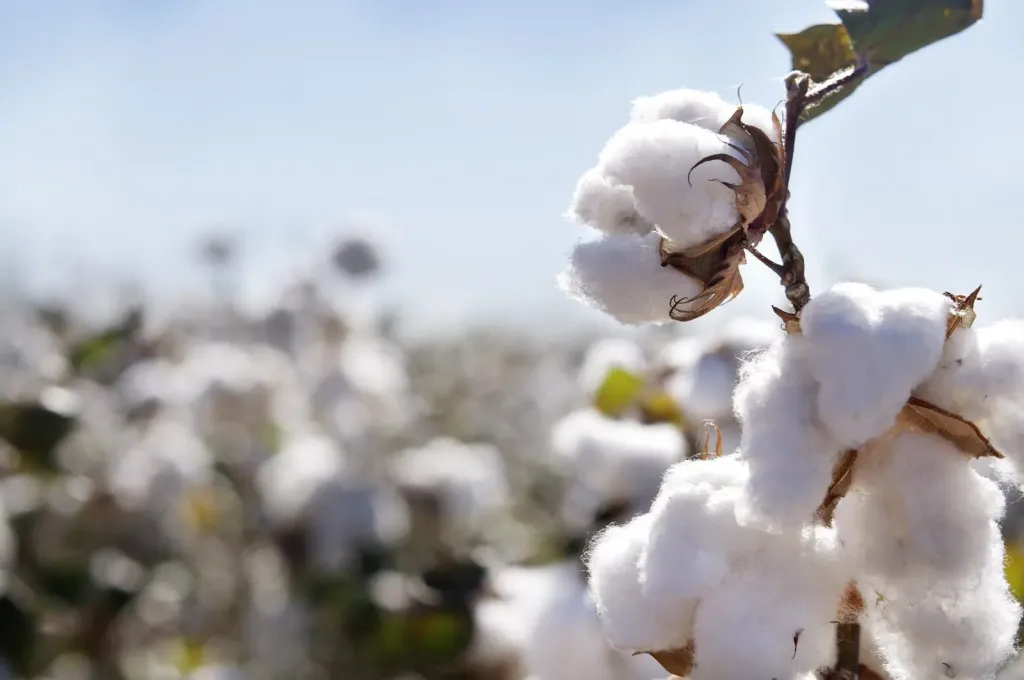The cotton flower is a beautiful bloom that can often be seen growing in gardens or wild open fields. It is a member of the mallow family, specifically the Gossypium species, and it grows in tropical and subtropical climates. The cotton flower has five petals that range from white to pinkish-purple in colour, with yellow stamens at the centre.
The cotton flower is pollinated by insects such as bees, butterflies and moths. These pollinators transfer pollen from one plant to another which helps with fertilization and helps ensure successful seed production for the next season’s crop of cotton flowers. As the blooms die off, they produce a round boll containing several seeds surrounded by fluffy fibres known as lint (or raw cotton). This lint can then be processed into clothing or other fabrics used for various purposes around the world.
Cotton flowers have been cultivated for centuries due to their economic importance as a source of raw materials for the textile industry all over the world it is estimated that nearly half of the world’s population wears clothing made out of this versatile fabric!
Benefits of Growing Cotton Flowers
If you’re looking for an easy-to-care-for, low-maintenance flower to add some life and beauty to your garden, then consider growing cotton flowers. Cotton flowers are a great way to add some colour and texture to your garden without having to worry about the usual maintenance that comes with other flowering plants. Here are just a few of the benefits of growing cotton flowers:
- Low Maintenance
When it comes to gardening, one of the main concerns is care and maintenance. Cotton flowers are relatively low maintenance compared to other flowering plants, as they don’t need much in terms of water or fertilizer. They’re also quite resilient against pests and disease, making them ideal for those who don’t want too much hassle when it comes to gardening.
- Versatility
Another great thing about cotton flowers is their versatility in design and shape options. You can easily create different designs by planting different types of cotton in different colours together or even adding some twigs or stones around the base of each plant for added texture and interest! This makes them ideal if you want something unique but easy when it comes to landscaping your garden beds or borders.
Common Uses for Cotton Flowers
Cotton flowers, also known as Gossypium species, are a versatile and popular flowering plant found in many parts of the world. These beautiful blooms have been used for centuries for a variety of purposes, including fabric production and medicinal treatments. In this article, we’ll discuss some of the common uses for cotton flowers.
The most well-known use of cotton flowers is in the production of fabric. Cotton plants produce fluffy white fibres that can be spun into yarn or threads to make various types of clothing or other textiles such as towels and bedding. Cotton is a breathable material that offers comfort and durability making it ideal for apparel items such as t-shirts and jeans. It’s also a great material to use in crafting projects like quilting or embroidery due to its softness and strength.
Another common use for cotton flowers is in their natural form dried out as decorations or potpourri mixtures. The small clusters look aesthetically pleasing when used alone or combined with other dried botanicals like lavender buds or rose petals to create colourful displays perfect for home decorating ideas like wreaths, centrepieces, gift baskets, etcetera.
Conclusion
In conclusion, the cotton flower is a beautiful and versatile plant that has been integral to human life for centuries. It can be used in a variety of ways to create clothing, fabric, paper, and other products. Its remarkable adaptability makes it an ideal crop for farmers around the world. Not only does it provide us with valuable resources, but its beauty has been celebrated in art and literature for centuries. The humble cotton flower is truly a remarkable gift from nature.
